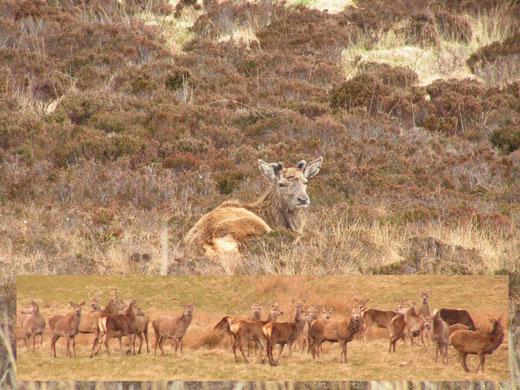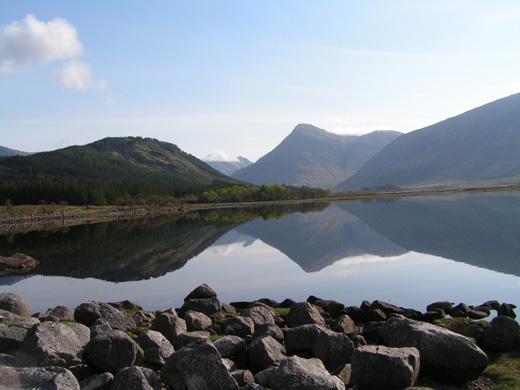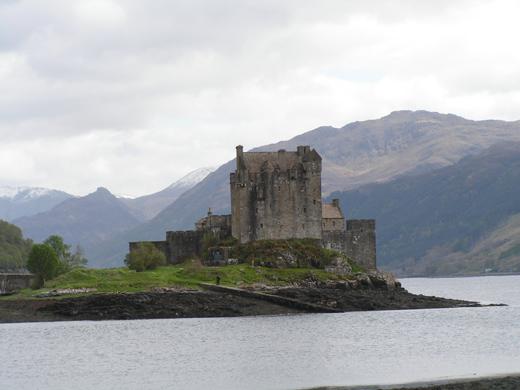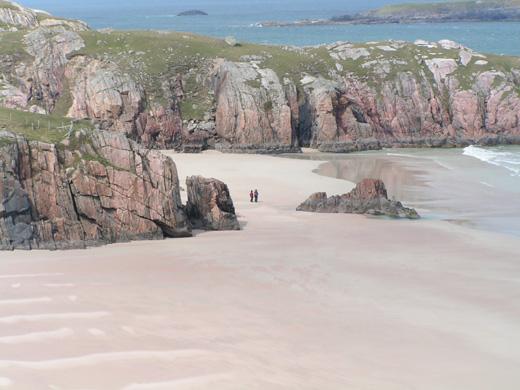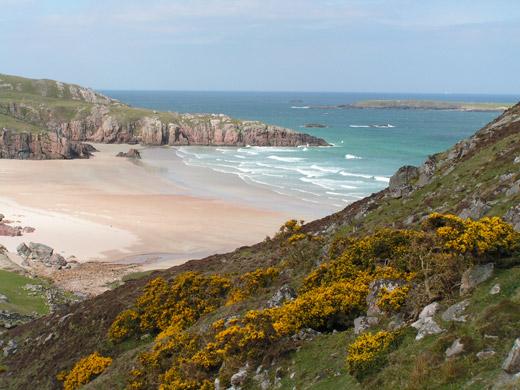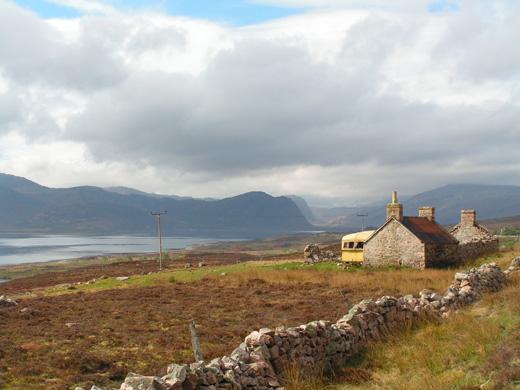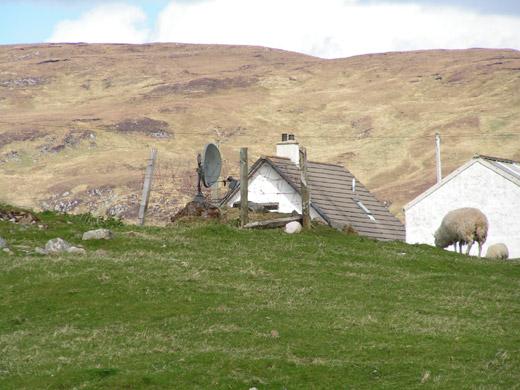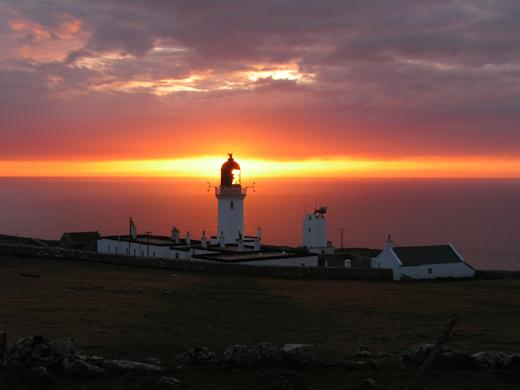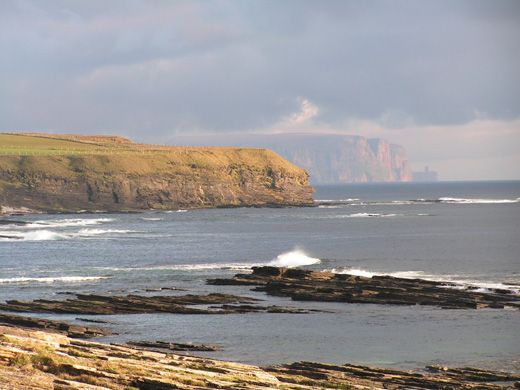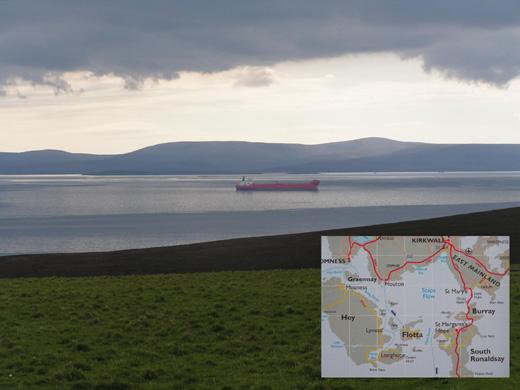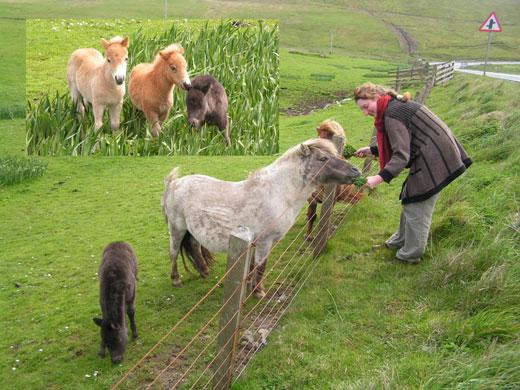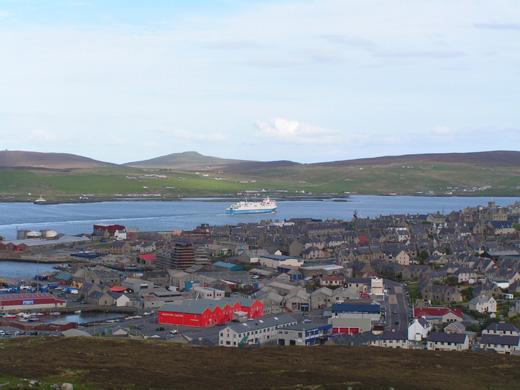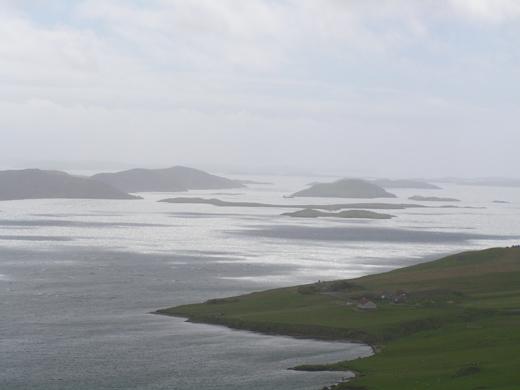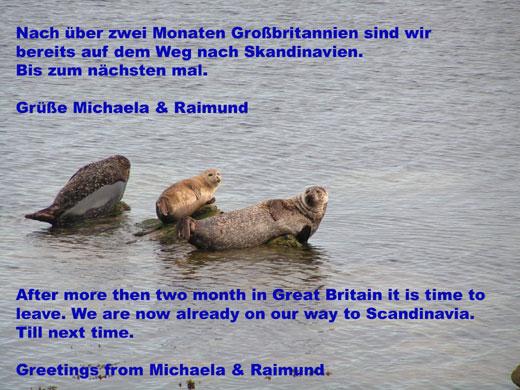We are still in the country of Lapland (Sapmi), which is a part of Norway, Sweden, Finland and the Russian Kola Peninsula. We drive from Norway to Sweden, from Sweden to Finland, from Finland to Norway again and that all in three days. Here in the North the border of this three countries are like criss cross, sometimes we don?t even know where we are right now.
See picture in German Version ? a Sami woman
Just on the bigger roads you find signs which tell us, that this is the border. Since a long time there are no more border controls at the barriers. We even gave it up to drive according to our roadmaps. The town signs are bilingual (Samisch and Norwegian/ Swedish or finish) but in the road maps there is standing a third variety. We drive along small settlements of huts and wooden houses. To call them ?villages? would be to much. Mostly they have such exotic names like Aissaroaivi or Beaivvaasgieddi. .
See picture in German version ? near Aissaroaivi
From now on we have much respect for the people living here in the middle of the forests of Lapland. Since one week we are now back again in the forests. First of all we thought: Oh how great, thousands of wonderful places to camp in the wilderness. No where any people around us. No wonder, because this country is so big, that the few tourists which are coming to the North are kind of disappear. We find a wonderful place just for us alone but five minutes later we are gone with the wind. Why, what happened? I am gone to pee, sorry normally I would not go so much into details, but here it is important, and while I am peeing three mosquito?s have been stung me on my ?backside? and at the same time about a dozen try to land on my face. Something like that I never have had in my live, not even in Thailand I had the experience, apart from the evenings but not during the daytime. Now I know, what people mean, when they say, that the inner part of Scandinavia belongs to a bloodsucking beast. But nevertheless we still have to stay in this forests, since it is still a few hunderts of kilometres to drive to the coast. And now comes the best! We have entirely shut the bus, as well the mosquito nets but it seems, that for this amount of mosquito?s even this is not enough. In the beginning we kill one after the other, but after a while we don?t have the nerves for it anymore. Next morning we wake up with about 40 mosquito?s inside the bus. The dead ones are still stuck to the windows as a kind of deterrence, but it did not work. We leave the place like a thunderstorm and drive until there is more wind around our noses because it seems that this is the only thing which the mosquito?s does not like at all. In the next bigger town we buy another mosquito net and meters of Velcro. No wonder that you can get this things easily, not even the natives like the mosquito?s. As well the reindeer are during the summer month up in the north at the coastlines, directly on the beaches.
See picture in German version? Mosquito free zone
But it?s funny, that when you talk to other tourists about mosquito?s, they pretend not to be bothered at all by them and they always just say: ?Well, you get used to it? Either they are just travelling along the coastline or they want to be cool. Funny enough that this people, which are trying to be most cool they have a kind of leprosy or are this maybe scratched mosquito stitches?
See picture in German version ? not even the mosquito?s can do something about, that we enjoy every minute here
We come back onto the road E 6 in Alta, the caravan way of the North cape driver and are part of the convoy of the motor homes, of which thousands of them are here during the summer month. To enter the most northern point, you have to pay an entrance fee. We do not even think about doing this stretch and therefore we save ourselves over 80 Euros (Entrance fee and toll for the undersea tunnel to the North cape) In Skaidi we drive to the left, direction Hammerfest. Shortly before the city of Hammerfest, there stands a model of a huge ice bear to tell everybody ?Hammerfest, the most northern city of the world? In Hammerfest, not a really nice city, we just stay for a short time. But it is interesting to sea all over reindeer. In front of shops, petrol stations and very often they even block the rush hour traffic.
See picture in German version ? Hammerfest
Near of Kvalsund we find a wonderful place to stay with a terrific view over the Fjord, where we stay a couple of days, especially to fix our new anti mosquito system. We go further through the sub-arctic landscape of the Northkinn peninsula on which a few fishing villages lie on a fissured coastline. But before that we come through a grey stone desert and this landscape has it?s own attraction. No trees to be found, no green colour at all. But if you look more close to the rocks, you realize the beauty of nature. Lichen!!! In all different colours, models and sizes.
See picture in German version ? lichen
See picture in German version ? in all colours and models
Shortly before midnight, in another ?darkless? night, we reach Mehamn, which lies directly at Sorfjorden. A simple fisher village, from which you find a lot of them here in the North. Who ever wants to see the typical construction style of North Norway will be disappointed. Russian and Norwegian troops drove out the occupying power of the Germans in autumn 1944 and nearly all of the settlements in North Norway were destroyed by the ?Politics of the burned earth?.
The street lead us another 20 km North till Slettnes tyr, where there stands the most northern mainland lighthouse of the world at 71? 05? 33?? N. The lighthouse is situated 550 km north of the polar circle and at the same latitude as the northernmost point of Alaska. We are right at the coast, covered with a few layers of pullover and jackets and watch the sun as she moves along the horizon of the Arctic ocean. Then some clouds cover the sun and the wind gets cooler. We go back to the bus in our warm beds and fall asleep immediately after a long day, till the heat of the sun wake us up again. It is already lunchtime.
See picture in German version 71? 05? 33?? N lighthouse of Slettnes
In the East of Slettness tyr lies the Varanger peninsula with the village called Berlevag. Bee line between this two settlements is just 45 km, where in-between is just the sea. To go with the car from one to the other village you have to go to Tana Bru and then crosswise over the Varanger peninsula altogether about 350 km. With that kind of streets you need for this stretch about 1 ? day. Well, time we have enough. The second possibility would be by the Hurtigruten post ship, which comes every evening at 8 pm to Mehamn and goes northbound to Berlevag. The crossing takes about 2 ? hours. We calculate which way would be cheaper for us. To go by ferry or to go by car. We don?t have to much of petrol anymore so we definitely have to go first of all to a petrol station. There are two of them here. One is out of order, the other opens ?maybe? on Monday again. So the decision is already taken out of our hands. We take the Hurtigruten to Berlevag. On the waves you can see foam. Sailors speak about rough sea. It is so foggy that we can?t even sea the coastline which is just 1 km far away. The weather don?t change even on the next day. That?s the time when our ?Mobile VW-Bus cinema? comes to action again. We look at DVD?s which we can play on our laptop. Next day the weather has changed. It is a real warm Summer day.
See picture in German version ? Berlevag
The street along the coastline leads us through a bizarre Fjord landscape, which is formed from erosion, cracked rocks and cliffs. Then in contrast we can see bays with wonderful white sand beaches, which easily can coop with the beauty of tropical beaches. In a lot of this bays along the arctic ocean we see ?Ghost villages?. Since the new street construction have been finished more and more people leave their home villages since this is a very inhospitable region.
See picture in German version ? Arctic ocean beach
Now we are coming to the east part of the Varanger peninsula. We drive the E 75, which ends in Vardoe (by the way, the beginning of the Europe street 75 starts on Crete) Vardoe lies on an island and is connected by a 2,9 km undersea tunnel with the mainland. The deepest point is 88 meters under sea level. There are nowadays living about 320 inhabitants on Vardoe. As well in Vardoe lots of people left, to live more south. As in 2001 the government of Norway announced the closing of the airport and the sea radio station, the inhabitants of Vardoe defended themselves. There would have been no more a helicopter ambulance. The next hospital to be reached is in Kirkeness, five hours by car. The town councillor resigned and gave business to the government to the 2500 km far away Oslo. From all over Norway TV camera teams came to Vardoe. The startled state chancellor of Norway did send a state secretary to Vardoe. The politician from the south thought, that the sea radio station with the name ?Vardoe Radio? is a local music station. Airport and sea radio station could stay in the end and even 30 more working places have been developed. A department for national working supervisory body have been moved to Vardoe.
From Mauri we let us bring with a small motorboat to the nearby bird island Hornoya and we arrange that he picks us up 4 hours later. The noise of the 120 000 bird couples is to hear already from a long distance. In that moment we step on the island there is an incredible smell. We pass the first hill and we know now why the smell is so bad. Towers of fecales of the birds. We leave the meal in our backpack, which we brought along with us. We don?t feel like eating at all. The pathway leads us crisscross passed the bird rock towards the lighthouse. The birds are flying in short distances over our heads. Very often we duck our heads. Thousands of birds are starting and landing at the same time from the rock without any collisions
See picture in German version ?ah, like this I have to fly, a small puffin at his flying school
All different kind of birds are living here on the bird islands. Next to cormorant, guillemot and different kind of seagulls most of the birds are puffins. Their real funny way of moving and their big coloured beak let them look like clowns. And, yes they are terrific photo models. In that moment a puffin realize that someone takes a picture of him, he poses. At least we have the feeling that they know. Very well done!
See picture in German version ? puffin
Some part of the islands are closed till the month of August, since the birds are breading. That?s the reason we do not leave the pathways. And now it happens. We both hoped, that it would not happen. Raimund walks in front of me and then he is attacked by a seagull. The seagull comes back and faces with her backside Raimunds head. Bulls eye!! Over his bald head, the neck and his pullover runs a stinky liquid. That was a neat peace of work. Not even a fighting pilot with a lot of electronic could have done better. But this was not all. The seagull comes back and attacks us with her sharp beak. Right away we move backwards out of her way. With binoculars we see know, why she attacked us so hardly. On the pathway to the lighthouse their was sitting her baby after the first flight lesson and could not move any more further. She just wanted to protect her little baby. We go back to the boat which we see already coming. The evening we spend cleaning bodies and clothes. A small street leads us about 40 km more northbound to a fishing village called Hamningberg and here the street ends.
See picture in German version? Hamningberg
Long time ago during fishing season over 6000 people used to life here. Today, the village is uninhabited. Just during the Summer month there is life again, when the owner of the holiday cottages are back to spend their vacation here. A view km outside of Hamningberg we find a wonderful place to stay for the night. In the evening, as we walk along the beach to collect shells, we can watch in 200 m distance about 50 beluga whales. We are really happy after this experience.
See picture in German version? Beluga whales at Hamningberg
After two more days we reach Kirkenes, the last town before the Russian border. On a sign we can read ? Munich 4443 km?. In the harbour a lot of Russian ships with lot of rust on it are anchored here. The Russian flags are blowing in the wind. Russia is not far away! There are just 20 km left to the border itself. We buy some groceries and drive to a nearby campground to take a shower and wash our clothes. Our destiny for the next days is a small village, named Grense Jakoselv, which lies directly at the Russian border. This will be our last time at the arctic ocean and we hope that we will have the chance to see a last time the midnight sun on a cloudless night
See picture in German version ? aureole or hypocritical?
A few hundred meters before the border Storskog, Norwegians only official border to Russia, the street turns left towards Grense Jakobselv. We are surprised that so many cars come to meet us. Because there is nothing else in that village then a chapel, a vicarage and a few empty houses. But today is Sunday and it is definitely worth a trip out here.
See picture in German version ? double seater WC, in the old vicarage at Grense Jakobselv
At the arctic ocean we find a wonderful place for the next three days to camp with terrific view over the ocean. We do small hikings along the coast and the river (in the middle of the river is the borderline to Russia. I try again to catch some fish and surprise Michaela with it, but unfortunately I am not successful.
See picture in German version ? Raimund is fishing
The weather changes a lot. Sometimes we get free showers from the rain, sometimes we sit endless hours in the sun. Nowhere is Norway more German then on the arctic Ocean. On the last day we sit comfortable together in Lissi and Dieters ?Repair truck?, a Mercedes 608D, building year 1977 and just enjoy the moment. We call it repair truck, because Dieter has in his self-made motor home more repairing gear then some of the garages would have. The nice globetrotter are living in D?sseldorf. Horst, a 70 year old man from Pinneberg, who drive alone through Norway, comes as well to sit with us. Everybody of us brings their last bit of alcohol with and it is becoming a real funny evening.
See picture in German version ? great evening in Lissis and Dieters ?living room?
The stationary heating is on since outside it is really cold. Horst tells us a lot of great stories from his time being sailor on several ocean going ships. We sit together till about 2 am and then ? the wind stopped in the meanwhile and the clouds are nearly all gone ? we walk together up to the cliffs and enjoy the marvellous view over the ocean with it?s colourful midnight sun. Then we finally go to bed. Next morning we drive back to Kirkenes. Lissi, Dieter and we decide to drive together the next 550 km towards the Gulf of Bothnia. The border to Finland is not far. We leave behind the forestless area and so more we come into Finland so more forested areas we see. At a lake we stay for another night
See picture in German version ? one of thousand lakes
It becomes a ritual. Motor homes in position, change things for the night, collecting wood, burn a fire and then the easy going life is starting.
See picture in German version?first of all comes the work
Sitting on the evenings at the campfire is the daily highlight. Mostly it is long after midnight that we find our way into our beds, smoked and tired. Today we have the first time mushrooms, picked ourselves from the forests. Waltraud and Rudolf from Berlin are joining us and so everybody just gets a fork and we all eat from the pan full of mushrooms. Well we will have mushrooms the next days more than enough. Here we certainly are more successful then with fishing.
See picture in German version ? lots of mushrooms
Every day we drive kilometre after kilometre through endless forests and lakes. In the evening we camp either at lakes or rivers. This is our schedule for the next days.
See picture in German version ?Camp at the Inari-See (holy lake of the Samis)
Shortly before Rovanniemi we stop at the polar circle. Here the Santa Claus is living. Yes, the real one. He has an own post office and answers together with his helpers year after year about 500 000 letters to all children all over the world. Most of the people don?t know the following: The Santa Claus lives in Rovanniemi, is married and has three children. By the way in the finish language Santa Claus is called Joulupukki. We are back to darkness. It is our first night south of the polar circle. It is the first night that it gets dark again, at least for a few hours per night. We did not thought, that it will be dark so soon. Back at the Gulf of Bothnia we stay together a couple more days.
See picture in German version ? Our night camp at Kemijoki, on the right side Lissis and Dieters red ?Motor home and Repair truck
The last day we camp on a campground so that we can take a shower and more necessarily wash clothes. Dieter, who actually should have been born as a screwdriver, at least found someone who needed his help. Next to us is a Swedish guy who was stucked in fresh tar. Now all over the tyres was fresh tar, which is hard to remove. Dieter is going right away to him and offers help. In his self-made motor home one can find from screws over special tools all kind of things Dieter is not only a superb mechanic as well a fantastic inventor. The VW K?fer of a couple in Brasilia he onetime did change into a functioned motor home. The sympathic 65 year old man is always ready to help. In the time when Lissi and Dieter travelled through Asia, North- and Southamerika he could help quiet often other travellers who where stucked with their motor homes. Even in mission stations he always offered his help for all kind of work. A lot of friendships have turned out of this time and they get still quiet regularly visits from all over the world. When you listen to the two, the wanderlust is getting up high into the red temperature. On our last evening together,r we eat once again mushrooms which we just picked in the nearby forests. There are plenty of them that you even don?t have to search for them just harvest them. Lissi and Michaela are playing a round of badminton, while Dieter and I are watching ?Dick and Doof? on the laptop.
See picture in German version ? Dieter and Raimund enjoy watching ?Dick and Doof?
This was a great time together with Dieter and Lissi. Time passed much to quick. After eight days together we are really sad to leave them. But Lissi and Dieter are going over Sweden back to Germany while we are on the way to Elsa and Matti in Oulainen. Elsa and Matti are the parents of our Finnish friend Liisa, which- as you know by now – lives in Munich.
Ok, that was it for now,
See picture in German version ?
Lots of greeting from the country of the thousands (mosquito)lakes.
Michaela und Raimund

